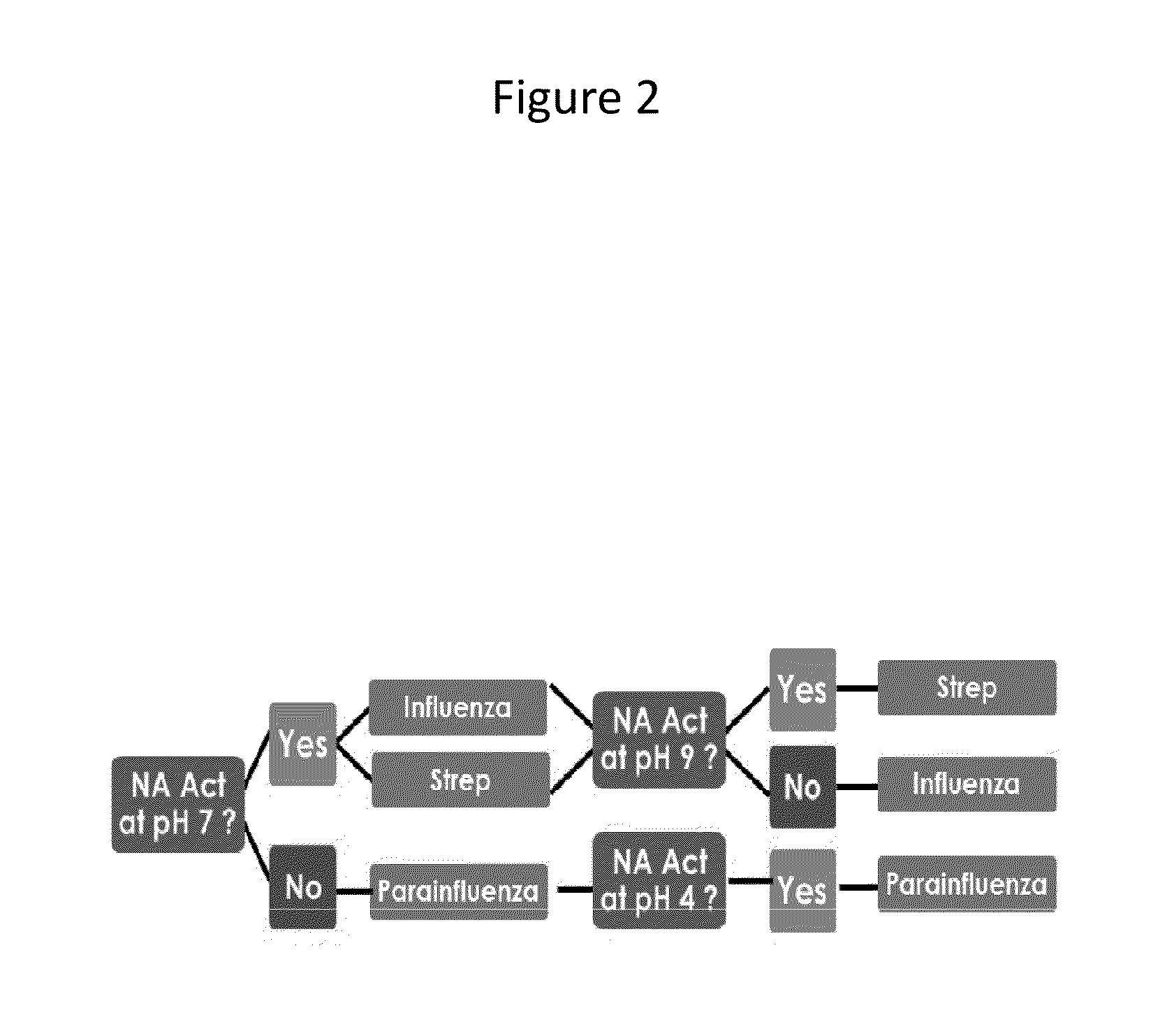Methods of Detecting Influenza Virus
a technology of influenza virus and detection method, which is applied in the field of detection of influenza virus, can solve the problems of global pandemic, death of over 21 million people, and increased risk of severe disease for pregnant women
- Summary
- Abstract
- Description
- Claims
- Application Information
AI Technical Summary
Benefits of technology
Problems solved by technology
Method used
Image
Examples
example 1
Differentiation of Influenza, Parainfluenza, and S. Pneumoniae Based on Measurement of NA Enzymatic Activity Under Differentiating Conditions of pH, Calcium, and Susceptibility to NA Inhibitors
[0079]Viral and bacterial strains assessed in this study are characterized in Table 1, below.
TABLE 1Characteristics of viral and bacterial strains% of max NAOselZanNAHAFFU peract. + EDTAIC50IC50Virus strainCtaact. RFUbTitermLc(pH)d(nM)(nM)H1N1 strainsA / California / 07 / 092366003207 × 108 44% (pH 6-7)0.91.3(H1N1pdm / 09-S)A / North Carolina / 39 / 09255300805 × 106 63% (pH 6-7)1251.2(H1N1pdm / 09-R)A / Brisbane / 59 / 07-Like2550001603 × 10754% (pH 6)22203.3(H1N1 / 07-R)A / Florida / 21 / 082547003202 × 10636% (pH 6)17292.2(H1N1 / 08-R)Recombinant N1 protein (purified recombinant protein expressed in human cells,obtained from Sino Biological Inc. http: / / www.sinobiological.com / )A / California / 04 / 09n / a16000 n / a1n / a 94% (pH 6-8)6225(N1pdm / 09-S)A / California / 04 / 09n / a13000n / an / a 94% (pH 6-8)7583.7(N1pdm / 09-R)A / Anhui / 01 / 05n / a12900n...
example 2
NA Enzymatic Activity of Influenza and S. pneumoniae in the Presence and Absence of Anti-NanA Antibody
[0086]The enzymatic domain of NanA was expressed as a His-tagged protein and used to produce polyclonal rabbit antiserum for NanA. The C-terminal domain of S. pneumoniae NanA (AE005672) was expressed with a hexahistidine tag for purposes of purification and antibody production. The template source was genomic DNA from S. pneumoniae strain TIGR4 (ATCC BAA-334). The vector was pET-22b(+). The NanA catalytic domain, PDB 2YA4 (NanA residues 307-777) was amplified using the following PCR primers: NanA_F2 (with 5′NdeI site) 5′-CATATGGCTTTAACAGAGAAAACG-3′ (SEQ ID NO: 1) and NanA_R2 (with 3′ HindIII site, stop codon removed to clone into pET-22b(+) with C-terminal hexahistidine tag) 5′-AAGCTTATTTTTGCTCAAAAATTCCC-3′ (SEQ ID NO: 2). The PCR amplification product was run on a 0.8% agarose gel and a 1.4 kb band was excised, purified, and sequenced to verify correct NanA sequence. NanA sequence ...
example 3
Differentiating Influenza from Other Pathogens by Size Exclusion
[0092]50-fold dilutions of influenza virus were prepared by mixing 80 μl of each viral stock into 4 ml distilled water. S. pneumoniae was grown overnight on blood agar and four colonies were suspended into 4 ml water. Half of the sample was filtered using cellulose acetate filters with different pore sizes (0.8, 0.45, and 0.22 μm). NA activity of both filtered and non-filtered dilutions was measured in PBS reaction buffer pH 6.5 containing 0.1 mM calcium and 10 nM MUNANA. 90 μl of viral dilutions were incubated with 10 μl of 10×PBS reaction buffer. For S. pneumoniae, 2 μl of the dilution were incubated in 100 μl reaction buffer. All reactions were incubated at room temperature and fluorescence was determined after 90 minutes.
[0093]As shown in FIG. 4, all of the NanA activity of S. pneumoniae was lost when the bacteria were filtered through 0.8, 0.45 or 0.22 micron filters. In contrast, much of the NA activity was retain...
PUM
 Login to View More
Login to View More Abstract
Description
Claims
Application Information
 Login to View More
Login to View More - R&D
- Intellectual Property
- Life Sciences
- Materials
- Tech Scout
- Unparalleled Data Quality
- Higher Quality Content
- 60% Fewer Hallucinations
Browse by: Latest US Patents, China's latest patents, Technical Efficacy Thesaurus, Application Domain, Technology Topic, Popular Technical Reports.
© 2025 PatSnap. All rights reserved.Legal|Privacy policy|Modern Slavery Act Transparency Statement|Sitemap|About US| Contact US: help@patsnap.com



